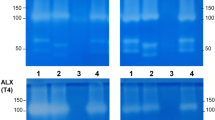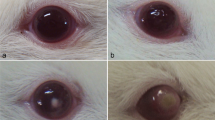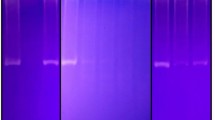Abstract
Background
Proteolytic enzymes secreted by trophozoites (amoebic secretome) are suggested as the main virulence factor involved in the severity of Acanthamoeba keratitis. The degradation profile of the main glycoprotein components of anterior and posterior portions of the cornea and the cytopathic effect of secretomes on endothelial cells by contact-independent mechanism were evaluated.
Methods
Trophozoites were isolated primarily from corneal tissue samples (n = 11) and extracellular proteins were collected from axenic cell culture supernatants. The molecular weights of proteolytic enzymes were estimated by zymography. Enzymatic cleavage of laminin and fibronectin substrates by amoebic secretome was investigated and cluster analysis was applied to the proteolysis profiles. Primary cultures of endothelial cells were used in both qualitative and quantitative assays of cytophatogenicity.
Results
Differential patterns of proteolysis were observed among the Acanthamoeba secretomes that were analysed. The uniformity of laminin degradation contrasted with the diversity of the proteolysis profiles observed in the fibronectin substrate. Acanthamoeba secretome extracted from four clinical isolates was shown to be toxic when in contact with the endothelial cell monolayer (p < 0.01). Induction of apoptosis and membrane permeability, at different percentual values, were suggested as the main mechanisms that could induce endothelial cell death when in contact with amoebic secretome.
Conclusions
Our results provide evidence that virulence factors secreted by Acanthamoeba trophozoites can be related to an increased pathogenicity pattern by an independent contact-trophozoite mechanism, through induction of endothelial cell death by apoptosis at a higher percentage than providing the lack of cell viability by the membrane-associated pore-forming toxin activity.






Similar content being viewed by others
References
DelMonte DW, Kim T (2011) Anatomy and physiology of the cornea. J Cataract Refract Surg 37:588–598
Hassell JR, Birk DE (2010) The molecular basis of corneal transparency. Exp Eye Res 91:326–335
Cejka C, Ardan T, Sirc J, Michálek J, Brůnová B, Cejková J (2010) The influence of various toxic effects on the cornea and changes in corneal light transmission. Graefes Arch Clin Exp Ophthalmol 248:1749–1756
Shao H, Scott SG, Nakata C, Hamad AR, Chakravarti S (2013) Extracellular matrix protein lumican promotes clearance and resolution of Pseudomonas aeruginosa keratitis in a mouse model. PLoS One 8:e54765
Otri AM, Fares U, Al-Aqaba MA, Dua HS (2013) Corneal densitometry as an indicator of corneal health. Ophthalmology 119:501–508
Visvesvara GS, Moura H, Schuster FL (2007) Pathogenic and opportunistic free-living amoebae: Acanthamoeba spp., Balamuthia mandrillaris, Naegleria fowleri, and Sappinia diploidea. FEMS Immunol Med Microbiol 50:1–26
Clarke DW, Niederkorn JY (2006) The pathophysiology of Acanthamoeba keratitis. Trends Parasitol 22:175–180
Panjwani N (2010) Pathogenesis of Acanthamoeba keratitis. Ocul Surf 8:70–79
Souza Carvalho FR, Carrijo-Carvalho LC, Chudzinski-Tavassi AM, Foronda AS, de Freitas D (2011) Serine-like proteolytic enzymes correlated with differential pathogenicity in patients with acute Acanthamoeba keratitis. Clin Microbiol Infect 17:603–609
Gipson IK, Joyce NC, Zieske JD (2005) The anatomy and cell biology of the human cornea, limbus, conjunctiva, and adnexa. In: Foster CS, Azar DT, Dohlman CH (eds) The cornea: scientific foundations and clinical practice. Lippincott Williams and Wilkins, Philadelphia, PA, pp 1–35
Kaji Y, Amano S, Usui T, Suzuki K, Tanaka S, Oshika T, Nagai R, Horiuchi S (2001) Advanced glycation end products in Descemet’s membrane and their effect on corneal endothelial cell. Curr Eye Res 23:469–477
Carvalho FRS, Foronda AS, Pellizari VH (2007) Detection of Legionella pneumophila in water and biofilm samples by culture and molecular methods from man-made systems in Sao Paulo-Brazil. Braz J Microbiol 38:743–751
Carvalho FR, Foronda AS, Mannis MJ, Höfling-Lima AL, Belfort R Jr, de Freitas D (2009) Twenty years of Acanthamoeba keratitis. Cornea 28:516–519
Visvesvara GS (2010) Parasite culture: Acanthamoeba and Naegleria spp. In: Garcia LS (ed) Clinical Microbiology Procedures Handbook. ASM Press, Washington, DC, pp 9.9.2.1–9.9.2.8
Heunssen C, Dowdle EB (1980) Electrophoretic analysis of plasminogen activators in polyacrylamide gels containing sodium dodecyl sulfate and copolymerized substrates. Anal Biochem 102:196–202
Jaffe EA, Nachman RL, Becker CG, Minick CR (1973) Culture of human endothelial cells derived from umbilical veins Identification by morphologic and immunologic criteria. J Clin Invest 52:2745–2756
Nishida T (2012) The role of fibronectin in corneal wound healing explored by a physician-scientist. Jpn J Ophthalmol 56:417–431
Torricelli AA, Singh V, Santhiago MR, Wilson SE (2013) The corneal epithelial basement membrane: structure, function, and disease. Invest Ophthalmol Vis Sci 54:6390–6400
Omaña-Molina M, González-Robles A, Iliana Salazar-Villatoro L, Lorenzo-Morales J, Cristóbal-Ramos AR, Hernández-Ramírez VI, Talamás-Rohana P, Méndez Cruz AR, Martínez-Palomo A (2013) Reevaluating the role of Acanthamoeba proteases in tissue invasion: observation of cytopathogenic mechanisms on MDCK cell monolayers and hamster corneal cells. Biomed Res Int 2013:461329
Rocha-Azevedo BD, Jamerson M, Cabral GA, Silva-Filho FC, Marciano-Cabral F (2009) Acanthamoeba interaction with extracellular matrix glycoproteins: biological and biochemical characterization and role in cytotoxicity and invasiveness. J Eukaryot Microbiol 56:270–278
Singh B, Fleury C, Jalalvand F, Riesbeck K (2012) Human pathogens utilize host extracellular matrix proteins laminin and collagen for adhesion and invasion of the host. FEMS Microbiol Rev 36:1122–1180
Tuft SJ, Coster DJ (1990) The corneal endothelium. Eye (Lond) 4:389–424
Gospodarowicz D, Greenburg G, Foidart JM, Savion N (1981) The production and localization of laminin in cultured vascular and corneal endothelial cells. J Cell Physiol 107:171–83
Rittig M, Brigel C, Lütjen-Drecoll E (1990) Lectin-binding sites in the anterior segment of the human eye. Graefes Arch Clin Exp Ophthalmol 228:528–32
Chua JS, Liew LX, Yim EKF (2013) Cultivation of human microvascular endothelial cells on topographical substrates to mimic the human corneal endothelium. J Funct Biomater 4:38–58
Mimura T, Yamagami S, Amano S (2013) Corneal endothelial regeneration and tissue engineering. Prog Retin Eye Res 35:1–17
Takahashi K, Sawasaki Y, Hata J, Mukai K, Goto T (1990) Spontaneous transformation and immortalization of human endothelial cells. In Vitro Cell Dev Biol 26:265–74
DeHahn KC, Gonzales M, Gonzalez AM, Hopkinson SB, Chandel NS, Brunelle JK, Jones JC (2004) The alpha4 laminin subunit regulates endothelial cell survival. Exp Cell Res 294:281–289
Yamaguchi M, Ebihara N, Shima N, Kimoto M, Funaki T, Yokoo S, Murakami A, Yamagami S (2011) Adhesion, migration, and proliferation of cultured human corneal endothelial cells by laminin-5. Invest Ophthalmol Vis Sci 52:679–684
Bednarz J, Weich HA, Rodokanaki-von Schrenck A, Engelmann K (1995) Expression of genes coding growth factors and growth factor receptors in differentiated and dedifferentiated human corneal endothelial cells. Cornea 14:372–381
Schilling-Schön A, Pleyer U, Hartmann C, Rieck PW (2000) The role of endogenous growth factors to support corneal endothelial migration after wounding in vitro. Exp Eye Res 71:583–589
Bazan HE (2005) Cellular and molecular events in corneal wound healing: significance of lipid signalling. Exp Eye Res 80:453–463
Lo NC, Turner NA, Cruz MA, Moake J (2013) Interaction of Shiga toxin with the A-domains and multimers of von Willebrand Factor. J Biol Chem 288:33118–33123
Shrader CD, Bailey KM, Konat GW, Cilento EV, Reilly FD (2009) Insulin enhances proliferation and viability of human umbilical vein endothelial cells. Arch Dermatol Res 301:159–166
Beji Z, Hanini A, Smiri LS, Gavard J, Kacem K, Villain F, Greneche JM, Chau F, Ammar S (2010) Magnetic properties of Zn-substituted MnFe2O4 nanoparticles synthesized in polyol as potential heating agents for hyperthermia Evaluation of their toxicity on endothelial cells. Chem Mater 22:5420–5429
Gutiérrez-Praena D, Pichardo S, Jos Á, Moreno FJ, Cameán AM (2012) Alterations observed in the endothelial HUVEC cell line exposed to pure Cylindrospermopsin. Chemosphere 89:1151–1160
Kinnear FB (2003) Cytopathogenicity of Acanthamoeba, Vahlkampfia and Hartmannella: quantative and qualitative in vitro studies on keratocytes. J Infect 46:228–237
Deo DD, Bazan NG, Hunt JD (2004) Activation of platelet-activating factor receptor-coupled G alpha q leads to stimulation of Src and focal adhesion kinase via two separate pathways in human umbilical vein endothelial cells. J Biol Chem 279:3497–3508
Alsam S, Sissons J, Jayasekera S, Khan NA (2005) Extracellular proteases of Acanthamoeba castellanii (encephalitis isolate belonging to T1 genotype) contribute to increased permeability in an in vitro model of the human blood–brain barrier. J Infect 51:150–156
Michalek M, Sönnichsen FD, Wechselberger R, Dingley AJ, Hung CW, Kopp A, Wienk H, Simanski M, Herbst R, Lorenzen I, Marciano-Cabral F, Gelhaus C, Gutsmann T, Tholey A, Grötzinger J, Leippe M (2013) Structure and function of a unique pore-forming protein from a pathogenic Acanthamoeba. Nat Chem Biol 9:37–42
Hurt M, Neelam S, Niederkorn J, Alizadeh H (2003) Pathogenic Acanthamoeba spp. secrete a mannose-induced cytolytic protein that correlates with the ability to cause disease. Infect Immun 71:6243–6255
Tripathi T, Smith AD, Abdi M, Alizadeh H (2012) Acanthamoeba-cytopathic protein induces apoptosis and proinflammatory cytokines in human corneal epithelial cells by cPLA2α activation. Invest Ophthalmol Vis Sci 53:7973–7982
Shivanna M, Srinivas SP (2009) Microtubule stabilization opposes the (TNF-alpha)-induced loss in the barrier integrity of corneal endothelium. Exp Eye Res 89:950–959
Srinivas SP (2012) Cell signaling in regulation of the barrier integrity of the corneal endothelium. Exp Eye Res 95:8–15
Dumontet C, Jordan MA (2010) Microtubule-binding agents: a dynamic field of cancer therapeutics. Nat Rev Drug Discov 9:790–803
Henriquez FL, Ingram PR, Muench SP, Rice DW, Roberts CW (2008) Molecular basis for resistance of Acanthamoeba tubulins to all major classes of antitubulin compounds. Antimicrob Agents Chemother 52:1133–1135
Acknowledgements
This work was supported by grants from Fundação de Amparo à Pesquisa do Estado de São Paulo (FAPESP Grant 2011/51626-1 to F. R. S.C.). D. F is a Research Fellow of the National Council for Scientific and Technological Development (CNPq Grant 311612/2012-1). L. C. C. is a postdoctoral fellow of the Coordenação de Aperfeiçoamento de Pessoal de Nível Superior (PNPD/CAPES). F. R. S. C. is a fellow of the Young Researchers at Emerging Centers Program of FAPESP (Grant 2012/15603-0).
Conflict of interest statement
The authors have no conflict of interest to declare.
Author information
Authors and Affiliations
Corresponding author
Electronic supplementary material
Below is the link to the electronic supplementary material.
ESM 1
(DOCX 1527 kb)
Rights and permissions
About this article
Cite this article
Sant’ana, V.P., Carrijo-Carvalho, L.C., Foronda, A.S. et al. Cytotoxic activity and degradation patterns of structural proteins by corneal isolates of Acanthamoeba spp. Graefes Arch Clin Exp Ophthalmol 253, 65–75 (2015). https://doi.org/10.1007/s00417-014-2783-3
Received:
Revised:
Accepted:
Published:
Issue Date:
DOI: https://doi.org/10.1007/s00417-014-2783-3




